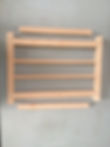RADHA PANDEY
Replicating Traditional Indo-slamic Papers
2012–Present


The frame used for this method of papermaking is strikingly similar to that of the Korean frame.

Burnished papers with Logwood, Cochineal, Black tea and Yellow onion dyes with ahar (egg size).

Click to Enlarge Images
Islamicate Papermaking as it is known, utilizes a flexible mould surface very similar to that of Japanese and Korean papermaking traditions. The impact of Islamic papermaking on the west is little known. During my research and time spent with the Hussain Kagzis (one of the 8 surviving families practicing this tradition today) I realized that they are a precious link to our history and provide an insight like no other. In an effort to highlight and promote their exquisite craft, skill and history, I have been giving presentations, demonstrations and workshops on traditional papermaking in India or Indo-Islamic papermaking. The paper is made by dipping the mould into the vat once. The mould is then floated and pushed gently back down into the vat until the freshly-formed sheet floats off the mould gently. It is then dipped a second time before couching. Dyes are traditionally added to the vat, and then brushed onto the finished sheets before burnishing with an agate stone. Watch my lecture at FIT on Papermaking in India here.